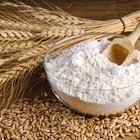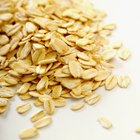More Articles
PointImages/iStock/GettyImages
The bewildering variety of flours in a well-stocked supermarket can be intimidating for a novice baker. Cake flour, bread flour, pastry flour, all-purpose flour and quick-mixing flour all have their own unique characteristics and uses. Most can be substituted with one or two of the others, if necessary. All-purpose flour, named for its versatility most often comes in bleached and unbleached versions, but other types of flour may also be available unbleached.
Milling 101
Until it was industrialized in the 19th century, flour was milled slowly on giant stones, and then sifted to remove the bran and germ and produce a relatively pale flour. Modern milling uses high-speed steel rollers instead, set to different spacings. The grain passes through several sets of rollers which crack the grains, remove the bran and germ, and then mill the remainder to fine flour. This high-speed milling generates a lot of heat and cooks out much of the flour's nutrients, so in the United States most flours are enriched to replace the lost vitamins.
Gluten Content
Most of the flours you see at the supermarket are differentiated by the amount of protein they contain. When they're moistened and mixed, the proteins in wheat flour form long, stretchy strands called gluten. Bread dough needs lots of gluten to trap the gas manufactured by its yeasts, producing a high, light loaf with pleasantly chewy texture. Cakes are the opposite, requiring a flour with very little gluten so they'll have a soft, tender crumb. All-purpose flours fall somewhere in the middle. In the U.S., cake flour usually has 7 to 8 percent gluten, and bread flour can have 13 percent or more. All-purpose flours usually range from 10 to 12 percent in most of the country.
Bleaching
Bakers and millers have known for many centuries that freshly ground flour makes relatively poor bread. It rises sluggishly and unpredictably, even when it has lots of gluten, and produces a dense loaf. If the flour was aged and transferred between storage bins, exposure to oxygen in the air slowly whitened its color and improved its baking qualities, yielding better results in almost all baked goods. In the 19th century, modern millers discovered that artificially bleaching the flour produced similar results. Most all-purpose flour, and almost all cake flour, was soon routinely bleached to produce better textures and a clean, white appearance in baked goods.
All-Purpose vs. Unbleached
Unbleached flour and all-purpose flour are functionally the same, so you can use them interchangeably in most baking. Regular all-purpose flour has been bleached with peroxide or other chemicals. The cleaner, lighter color of all-purpose flour can be a positive in cakes, biscuits and other baking where whiteness or true colors are valued. Unbleached flour is more flavorful, slightly more nutritious and definitely less processed. It may be darker in color or have a slightly rougher texture. Unbleached flour produces breads and rolls with a creamy off-white texture, rather than pure white, but with a very similar texture and height as those made with bleached all-purpose flour.
Related Articles

Can You Substitute Whole Wheat Pastry ...

What Additives Are in Flour?

Bread Flour vs. Cake Flour in Sponge ...
Can You Substitute Whole-Wheat Pastry ...

Differences Between Bleached Flour & ...

Does Flour Get Old or Go Bad?
What Kind of Flour Do You Use for a ...

Alternative Flours to Make Pizza

What Are the Functions of Flour in ...

What Kind of Oil Do You Use in Brownie ...

Can I Substitute Bleached for ...
Does Cake Flour Contain Baking Soda & ...

What Kind of Flour to Use for Cupcakes?

Difference Between Red & White Wheat

Can You Use Bread Flour Instead of ...
What Is the Difference Between Cake ...
What Gives Pumpernickel Bread Its Dark ...

How to Substitute Cornstarch for ...

Purpose of Rolled Oats in Baking

If Flour Has Never Been Opened Can It ...
References
- On Food and Cooking: The Science and Lore of the Kitchen; Harold McGee
- The Professional Pastry Chef; Bo Friberg
- The Cook's Thesaurus: Wheat Flours
Writer Bio
Fred Decker is a trained chef and prolific freelance writer. In previous careers, he sold insurance and mutual funds, and was a longtime retailer. He was educated at Memorial University of Newfoundland and the Northern Alberta Institute of Technology. His articles have appeared on numerous home and garden sites including GoneOutdoors, TheNest and eHow.